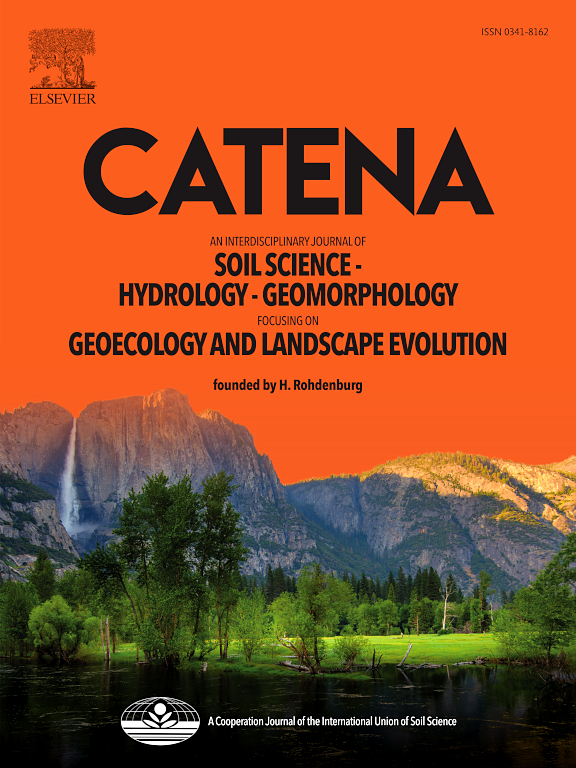了解复杂环境系统中冲积沉积物的地球化学组成--穆拉河/穆尔河案例研究
IF 5.4
1区 农林科学
Q1 GEOSCIENCES, MULTIDISCIPLINARY
引用次数: 0
摘要
这项研究全面考察了穆拉河(奥地利、斯洛文尼亚、欧盟)跨境地区复杂的自然(地球化学)和人为环境下的溪流和冲积沉积物的地球化学特性。共收集并分析了来自活动河道和支流的 65 个沉积物样本,以及来自 6 个洪泛区沉积物剖面的 59 个样本。采用 ICP-MS 分析方法测定了两个馏分(0.063 毫米和 0.063-0.125 毫米)中 59 种元素的含量。确定了影响元素组成的自然(地质)和人为因素。沉积物显示,河流上游风化程度较低,中下游风化程度适中。与欧洲河流和洪泛平原沉积物的中值相比,这些沉积物富含砷、钴、铬、铜、钼、镍和锑。这可能是上施蒂里亚州存在天然矿化及相关岩性特征的结果。因子分析揭示了四种天然地球化学关联(K-Ba-Rb-Ga-Li-Tl-Cs-Be-Al-Cu-V;Th-YREE-U;Zr-Hf-Nb;Na-Sr)、一种人为关联(Cd-In-Zn-Pb)和两种组合(地球和人为)关联(Ni-Cr-Mg-Co-V 和 Fe-Sc-Ti-Nb)。利用扫描电镜/电子显微镜对颗粒进行分析,以确定特定元素的特征载体,并有可能确定其来源。本文章由计算机程序翻译,如有差异,请以英文原文为准。

Understanding the geochemical composition of alluvial sediments in a complex environmental system – A case study of the Mura/Mur river
The study provides a comprehensive investigation of the geochemical properties of stream and alluvial sediments in an area characterised by a complex natural (geochemical) and anthropogenic environment of the transboundary Mura River (Austria, Slovenia, EU). A total of 65 sediment samples from active river channel and tributaries, and 59 samples from 6 floodplain sediment profiles were collected and analysed. ICP–MS analysis was used to determine the levels of 59 elements in two fractions (<0.063 and 0.063–0.125 mm). Natural (geological) and anthropogenic factors influencing the elemental composition were determined. The sediments showed a low degree of weathering in the upper part of the river and a moderate degree in the middle and lower parts. They are enriched with As, Co, Cr, Cu, Mo, Ni, and Sb compared to the median values for the European stream and floodplain sediments. This can be a consequence of the presence of natural ore mineralisation in Upper Styria along with related lithological features. Factor analysis revealed four natural geochemical associations (K–Ba–Rb–Ga–Li–Tl–Cs–Be–Al–Cu–V; Th–YREE–U; Zr–Hf–Nb; Na–Sr), one anthropogenic association (Cd–In–Zn–Pb) and two combined (geogenic and anthropogenic) associations (Ni–Cr–Mg–Co–V and Fe–Sc–Ti–Nb). Particle analysis by SEM/EDS was used to identify characteristic carriers of specific elements and potentially to determine their sources.
求助全文
通过发布文献求助,成功后即可免费获取论文全文。
去求助
来源期刊

Catena
环境科学-地球科学综合
CiteScore
10.50
自引率
9.70%
发文量
816
审稿时长
54 days
期刊介绍:
Catena publishes papers describing original field and laboratory investigations and reviews on geoecology and landscape evolution with emphasis on interdisciplinary aspects of soil science, hydrology and geomorphology. It aims to disseminate new knowledge and foster better understanding of the physical environment, of evolutionary sequences that have resulted in past and current landscapes, and of the natural processes that are likely to determine the fate of our terrestrial environment.
Papers within any one of the above topics are welcome provided they are of sufficiently wide interest and relevance.
 求助内容:
求助内容: 应助结果提醒方式:
应助结果提醒方式:


